8A Unit1 Friends教案
8A Unit1 Friends教案-2023-2024学年牛津译林版英语八年级上册
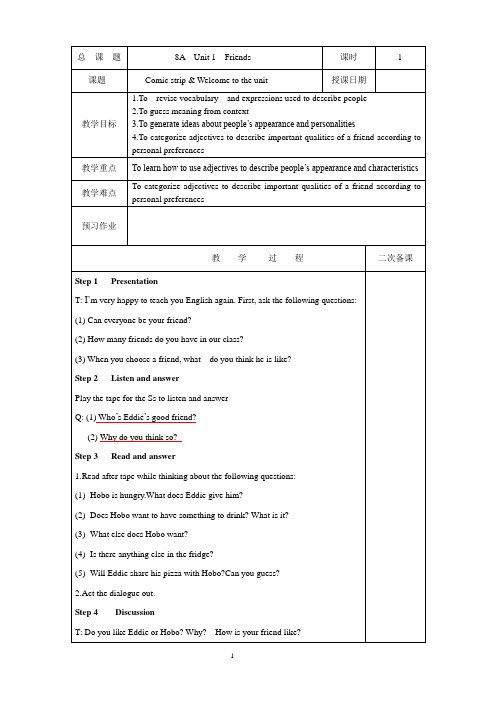
教学难点
To categorize adjectives to describe important qualities of a friend according to personal preferences
预习作业
教学过程
二次备课
Step 1 Presentation
T:I’m very happy to teach you English again. First, ask the following questions:
教学难点
How to use adjectives to describe people’s appearance and characteristics.
预习作业
教学过程
二次备课
Step 1 Revision.
1.What are the most important qualities of a good friend?
T:‘Teenagers’magazine is holding a writing competition. Some students havewrittensome entries for it. Please read and find out their main qualities.
1---generous, helpful
Long legs do not fit under the school desks..
Can keep a secret
Never say a bad word about anyone
Step 5 Retell
1. T: So we have got a table about them. And you have known a lot about them.Can you say sth about themaccordingto the information in the table.
牛津译林版八年级英语上册8A Unit1 Friends 单元教案
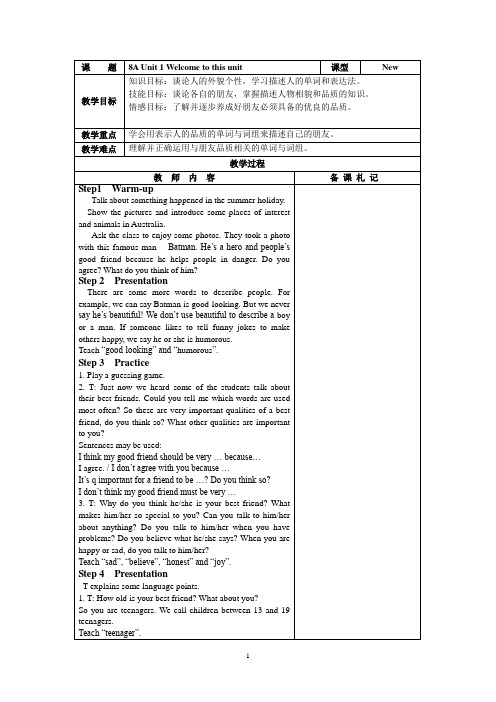
Ask the students toread the Comic strip and answer the questions:
(1) What does Eddie give Hobo?
Step6Homework
1. Describe a good friend of yours with the words and phrases learnt in this lesson.
2. Finish the Workbook exercises.
板书设计
教学反思
课题
8A Unit 1 Friends Reading (1)
Step 5 Retell
1. T: So we have got a table about them. And you have known a lot about them.Can you say sth about themaccordingto the information in the table.
Sentences may be used:
I think my good friend should be very … because…
I agree. / I don’t agree with you because …
It’s q important for a friend to be …? Do you think so?
Eyes, nose: big, small
Face: round, square
Body: thin, strong, slim, fat, tall, short
8A Unit1 Friends 教案
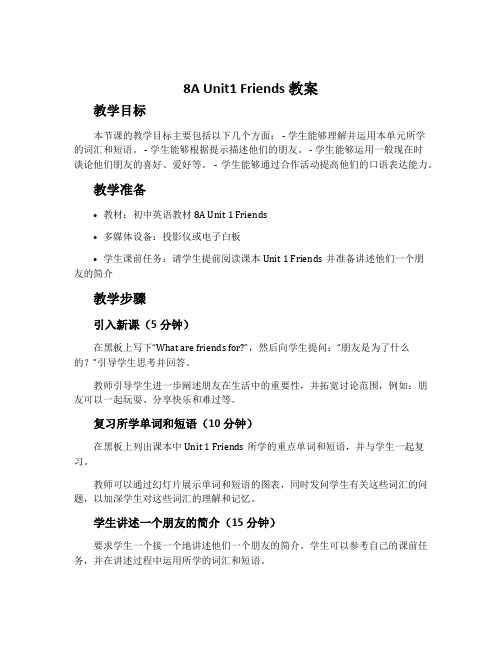
8A Unit1 Friends 教案教学目标本节课的教学目标主要包括以下几个方面: - 学生能够理解并运用本单元所学的词汇和短语。
- 学生能够根据提示描述他们的朋友。
- 学生能够运用一般现在时谈论他们朋友的喜好、爱好等。
- 学生能够通过合作活动提高他们的口语表达能力。
教学准备•教材:初中英语教材8A Unit 1 Friends•多媒体设备:投影仪或电子白板•学生课前任务:请学生提前阅读课本Unit 1 Friends并准备讲述他们一个朋友的简介教学步骤引入新课(5分钟)在黑板上写下“What are friends for?”,然后向学生提问:“朋友是为了什么的?”引导学生思考并回答。
教师引导学生进一步阐述朋友在生活中的重要性,并拓宽讨论范围,例如:朋友可以一起玩耍、分享快乐和难过等。
复习所学单词和短语(10分钟)在黑板上列出课本中Unit 1 Friends所学的重点单词和短语,并与学生一起复习。
教师可以通过幻灯片展示单词和短语的图表,同时发问学生有关这些词汇的问题,以加深学生对这些词汇的理解和记忆。
学生讲述一个朋友的简介(15分钟)要求学生一个接一个地讲述他们一个朋友的简介。
学生可以参考自己的课前任务,并在讲述过程中运用所学的词汇和短语。
教师可以适时给予学生鼓励和肯定,并在学生讲述过程中纠正他们可能出现的语法错误或用词不当的情况。
学习一般现在时谈论朋友(20分钟)在黑板上写下一般现在时的基本结构,并解释动词的变化规则。
教师可以通过示范句子的方式,引导学生理解一般现在时在谈论朋友时的用法。
例如,教师可以问学生:“What does your friend like to do in his/her free time?。
[精品K12]8A Unit 1 Friends上课学习上课学习教案
![[精品K12]8A Unit 1 Friends上课学习上课学习教案](https://img.taocdn.com/s3/m/3fae60e580eb6294dd886cf7.png)
8A Unit 1 Friends教案www.5ykj.com中学英语学科教案总课题8AUnit1Friends总课时10第1课时课题welcometotheunit课型New教学目标知识目标1.To revisevocabularyandexpressionsusedtodescribepeople2.Toguessmeaningf romcontext3.Togenerateideasaboutpeople’sappearanceandpersonalities4.Tocategorizeadjectives todescribeimportantqualitiesofafriendaccordingtoper sonalpreferences能力目标Tounderstandtheconceptofthingsthatareunusual.情感目标Touseadjectivestodescribefeelingsandopinions教学重点Tolearnhowtouseadjectivestodescribepeople’sappearanceandcharacteristics教学难点Tocategorizeadjectivestodescribeimportantqualitieso fafriendaccordingtopersonalpreferences课前预习1.Previewthenewwords.2.Listentothetapeandreadthedia logue.教学方法情景交际法、任务型教学法教学过程教学环节教师活动学生活动备课札记Step1warm-upStep2:PresentationStep3PracticeStep4:Pr esentationStep5PracticeStep6SummarizeStep7HomeworkT :Helloeveryone,gladtoseeyouagain!Didyouhaveanicesum merholiday?Areyouhappytobebacktoschoolandseeallyour friends?Sstalkabouttheirsummerholidays.T:Thissummer holidayIwenttoAustraliawithsomeofyourclassmatesandf riends.wetookalotofphotos.wouldyouliketohavealook?S howthepicturesandintroducesomeplacesofinterestandan imalsinAustralia.T:Look,wetookaphotowiththisfamousm an---Batman.He’saheroandpeople’sgoodfriendbecausehehelpspeopleindanger.Doyouagree? whatdoyouthinkofhim?SstalkaboutBatmanwiththeadjecti vesdescribingappearanceandpersonality,suchasfriendl y,helpful,kind,polite,clever,brave,etc.T:Thereareso memorewordstodescribepeople.Forexample,wecansayBatm anisgood-looking.Butweneversayhe’sbeautiful!wedon’tusebeautifultodescribeaboyoraman.Ifsomeonelikesmus icorisgoodatmusic,wesayheorsheismusical.Teach “good-looking”and “musical”.1.Playaguessinggame.Ssdescribetheirbest friendsintheclassandguesswhoaretalkedabout.2.T:just nowweheardsomeofthestudentstalkabouttheirbestfriend s.couldyoutellmewhichwordsareusedmostoften?Ss:frien dly,helpful,polite…T:Sotheseareveryimportantqualitiesofabestfriend,doy outhinkso?whatotherqualitiesareimportanttoyou?Sscom pletethetableinPartB,P7.Thenworkinpairstoexchangeth eirideasandhaveadebate.Sentencesmaybeused:Ithinkmyg oodfriendshouldbevery…because…Iagree./Idon’tagreewithyoubecause…It’squiteimportantforafriendtobe…?Doyouthinkso?Idon’tthinkmygoodfriendmustbevery…3.T:whydoyouthinkhe/sheisyourbestfriend?whatmakeshi m/hersospecialtoyou?canyoutalktohim/heraboutanythin g?Doyoutalktohim/herwhenyouhaveproblems?Doyoubeliev ewhathe/shesays?whenyouarehappyorsad,doyoutalktohim /her?why?Teach“sad”,“believe”,“honest”and “joy”.SscompletePartA,P7andreportindividually.4.Texplainssomelanguagepoints.1.T:Howoldisyourbestfrie nd?whataboutyou?Ss:15/16…T:Soyouareteenagers.wecallchildrenbetween13and19tee nagers.Teach“teenager”.T:wehaveagoodfriend,Eddie.Isheateenage r?Ss:No.2.T:who’sEddie’sgoodfriend?why?TplaysthetapeofthecomicstripandSstr ytofindouttheanswertothequestion.3.Ssreadthecomicst ripandanswerthequestions:whatdoesEddiegiveHobo?whatdoesHobowant?DoyouthinkEddieisatruefriend?why?4 .Ssreadthedialogueinpairs.5.Texplainssomelanguagepo ints.1.Ssactoutthedialogueandtheyareencouragedtoadd insomethingtheylike.2.Discuss:whodoyoulikebetterasa friend,EddieorHobo?why?3.Ssworkinpairstoaskandanswe rabouttheirgoodfriends.Amodeldialogue:A:who’syourgoodfriend?B:…A:what’she/shelike?B:…A:whatdoyouthinkofyourfriend?B:…A:whatmakeshim/hersospecialtoyou?B:…canyoutellmesomethingaboutyourgoodfriend?T:Todayweh avelearnedsomeimportantqualitiesaboutagoodfriend.It seemsthatweallthinkappearanceisnotsoimportant,butafriendshouldbehelpfulandhonest.AndIhopeeveryonecanbe likethatandyouwillhavemorefriends.1.Describeagoodfr iendofyourswiththewordsandphraseslearntinthislesson .2.Finishtheworkbookexercises.板书设计Unit1FriendsPhrases:havesomethingtodrink,makesomebodyhap py/special,keepsecrets,shareone’sjoy,believewhatsomebodysays,talktosomebodyaboutany thing,cleanandtidySentences:Doyouwantsome?canIhavesomethingtodrink?whataboutsomemilk?canIhavesomemorefoodtoo?There’snothingelseinthefridge.教学反思总课题8AUnit1Friends总课时10第2课时课题ReadingI课型New教学目标知识目标1.Toguessgeneralmeaningsfromkeywordsandcontext2.Tos kimtextforoverallmeaningsandscanfordetails3.Toident ifyspecificinformationaboutdifferentpeopleformtheir friends’descriptions4.Touseadjectivestodescribepeople’sappearanceandpersonalities能力目标Byreadingaboutthethreefriendsappearthebasicsituatio n,Understandingfriendwithdescribewordstodescribethe appearanceandpersonalityofdiscourse.情感目标Learntoappreciateothers,learntotreasurethefriendshi p.教学重点Toguessgeneralmeaningsfromkeywordsandcontext教学难点Toidentifyspecificinformationaboutdifferentpeoplefo rmtheirfriends’descriptions课前预习1Previewthenewwords.2Listentothetapeandreadthetext 教学方法情景教学法、归纳法教学过程教学环节教师活动学生活动备课札记Step1:Revision.Step2:PresentationStep3PracticeStep4 PresentationStep5PracticeStep6SummarizeStep7Practic eStep8HomeworkT:yesterdaywelearnttotalkaboutfriends .Friendsareveryimportantinourlives.Almosteveryonene edsafriendandalmosteveryonehasafriend,doyouthinkso? Let’slookatsomeinterestingEnglishsayingsaboutfriends.Pl easetrytoguessthemeaningsofthem.Ssreadanddiscuss.T:whydoyouthinkfriendsareimportant?whatcanfriendsdofo ryou?Ssgivedifferentanswers.T:Isyourfriend’sappearanceveryimportanttoyou?Ss:No.T:Good.weshould neverjudgeapersonbyhisappearanceorclothes.Butit’llbegoodforyoutolearnsomewordstodescribeyourfriends ’appearance,right?Tshowsthepicturesandteaches “shoulder-length”,“slim”and “pooreyesight”.SsdoPartB2,P9individually.Afterche ckingtheanswers,TaskssomeSstogivesomemoredetailsabo uttheappearanceofeachpersoninthepictures.1.T:Asyoua llthinkthatappearanceisnotveryimportant,couldyoutel lmewhatisimportantinyouropinion?Ssanswerwiththeadje ctivestheylearnttodescribequalities,suchascleanandt idy,helpful,honest,etc.T:Excellent.NowIhavesomegood friendshere.canyouusesomeproperwordstodescribethem? Ssfillintheblankstocompletethesentences.Tteaches “generous”,“joke”,“humorous”,“haveagoodsenseofhumour”,“atruefriend”and “beready/willingtodosth”.2.T:‘Teenagers’magazineisholdingawritingcompetitionaboutgoodfriend s.Somestudentshavewrittensomeentriesforit.Pleaserea dandfindoutwhetherthefollowingstatementsaretrueorfalse.T:playsthetaperecorderfortheSstorepeat.Ssreadan ddoPartc1,P10.3.SsreadagainanddoPartB1ontheirown.Te llthemthattheyneedtolookforspecificdetails,whichfit eachofthepersonsdescribedinthearticles.1.Sshaveagro upcompetitionbychoosingtoanswerthequestionsaboutBet tyinthetable.2.Fillintheblankstocompletethedescript pletethebriefintroductionaboutmay. T:whatdoweusuallywriteaboutwhenwedescribeourfriends ?Ss:Appearance,personalities…T:yes,inwhichparagraphdoweusuallywriteabouttheappea rance?Ss:Paragraph1.T:AndinParagraph2?Ss:Personalit ies.T:Right.wealsocallitpersonalities.Inthe3rdparag raphwecanwriteabouttheirbehaviorsorfutureplans.1.Ss doPartc2,P10andfindoutwhoeachofthepersonalitieswill voteforandfillintheblanks.Thenchecktheanswersbyaski ngandansweringinpairs‘whowillAmy/Simon/Sandyvotefor?’2.Ssvoteforoneofthe‘bestfriends’describedinthearticlesandtellthereasonwhy.3.Ssdoacl assvotefora‘bestfriend’.writeabriefdescriptionaboutapersonth eyconsiderasabestfriend.Readsomeofthedescriptionsandthenvoteforoneofthem.Explainwhytheyvoteforthatpart icularperson.1.Retellaboutthethreebestfriends.2.Rec ommendabeststudentinyourclassandtellthereasonwhyyou voteforhimorher.板书设计Unit1Friendswords:slim,shoulder-length,generous,singer,a lmost,eyesight,smart,truePhrases:travelaroundthewor ld,havepooreyesight,haveagoodsenseofhumour,knockoff ,atruefriend,sayabadwordaboutanyone,votefor教学反思总课题8AUnit1Friends总课时10第3课时课题ReadingⅡ课型New教学目标知识目标1.Tolearnsomeusefulexpressionsandusethemindifferent context2.Tolearnhowtodescribefriends能力目标Byreadingaboutthethreefriendsappearthebasicsituatio n,Understandingfriendwithdescribewordstodescribethe appearanceandpersonalityofdiscourse.情感目标Learntoappreciateothers,learntotreasurethefriendshi p.教学重点Touseadjectivestodescribesb’sappearanceandcharacteristics教学难点Todevelopagoodattitudetowardsfriends课前预习1.Listentothetapeandreadthetext2.Tosummarizekeypointsofastorybysequencingstatements教学方法讲授法练习法教学过程教学环节教师活动学生活动备课札记Step1RevisionStep2:LanguagepointsStep3:ExercisesSte p4:SummarizeStep5PoemStep6Homework1.T:Foryesterday’shomeworkIaskedyoutovoteforabeststudentinyourclass. Nowcanyoutellmeyourchoiceandyourreason?Pleasedescri bethatpersonindetailsandlet’sguesswhoitis.Thenwecanvoteforhimorher,ok?2.T:yeste rdaywealsometthreefriendsin‘Teenagers’magazine.They’reBetty,maxandmay.Howmuchdoyourememberthem?Sshaveag roupcompetitionbyansweringquestionsaboutmax.T:wonde rful!youhaveaverygoodmemory.Nowlet’smoveontolookatsomeusefulphrasesandsentencesintheth reearticlesandlearntousethem:1.SheisasslimasIam.她和我一样苗条。
译林版8A Unit 1 Friends教学案
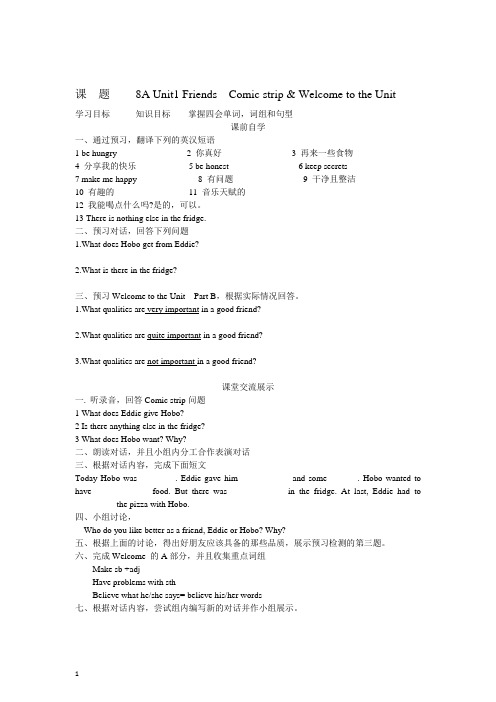
课题8A Unit1 Friends Comic strip & Welcome to the Unit学习目标知识目标掌握四会单词,词组和句型课前自学一、通过预习,翻译下列的英汉短语1 be hungry2 你真好3 再来一些食物4 分享我的快乐5 be honest6 keep secrets7 make me happy 8 有问题9 干净且整洁10 有趣的11 音乐天赋的12 我能喝点什么吗?是的,可以。
13 There is nothing else in the fridge.二、预习对话,回答下列问题1.What does Hobo get from Eddie?2.What is there in the fridge?三、预习Welcome to the Unit Part B,根据实际情况回答。
1.What qualities are very important in a good friend?2.What qualities are quite important in a good friend?3.What qualities are not important in a good friend?课堂交流展示一.听录音,回答Comic strip问题1 What does Eddie give Hobo?2 Is there anything else in the fridge?3 What does Hobo want? Why?二、朗读对话,并且小组内分工合作表演对话三、根据对话内容,完成下面短文Today Hobo was ________. Eddie gave him ___________ and some_______. Hobo wanted to have ____________ food. But there was ____________ in the fridge. At last, Eddie had to _________ the pizza with Hobo.四、小组讨论,Who do you like better as a friend, Eddie or Hobo? Why?五、根据上面的讨论,得出好朋友应该具备的那些品质,展示预习检测的第三题。
《8A Unit 1 Friends》教学设计-优秀教案
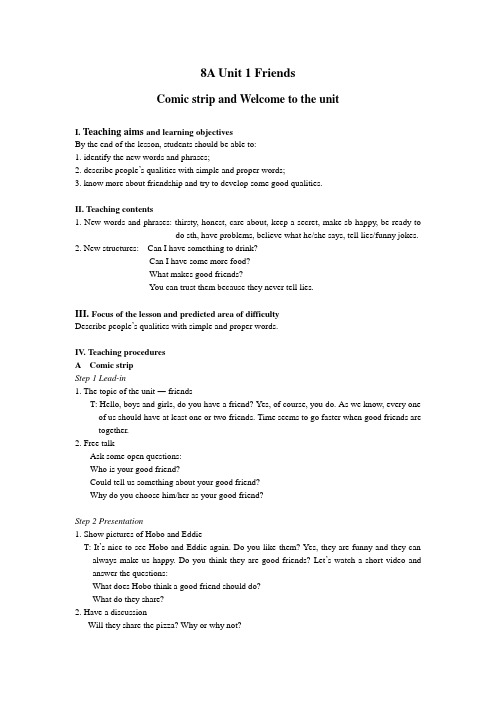
8A Unit 1 FriendsComic strip and Welcome to the unitI. Teaching aims and learning objectivesBy the end of the lesson, students should be able to:1. identify the new words and phrases;2. describe people’s qualities with simple and proper words;3. know more about friendship and try to develop some good qualities.II. Teaching contents1. New words and phrases: thirsty, honest, care about, keep a secret, make sb happy, be ready todo sth, have problems, believe what he/she says, tell lies/funny jokes.2. New structures: Can I have something to drink?Can I have some more food?What makes good friends?You can trust them because they never tell lies.III. Focus of the lesson and predicted area of difficultyDescribe people’s qualities with simple and proper words.IV. Teaching proceduresA Comic stripStep 1 Lead-in1. The topic of the unit ― friendsT: Hello, boys and girls, do you have a friend? Yes, of course, you do. As we know, every one of us should have at least one or two friends. Time seems to go faster when good friends are together.2. Free talkAsk some open questions:Who is your good friend?Could tell us something about your good friend?Why do you choose him/her as your good friend?Step 2 Presentation1. Show pictures of Hobo and EddieT: It’s nice to see Hobo and Eddie again. Do you like them? Yes, they are funny and they can always make us happy. Do you think they are good friends? Let’s watch a short video and answer the questions:What does Hobo think a good friend should do?What do they share?2. Have a discussionWill they share the pizza? Why or why not?Two possible answers: Yes, they will share. Because good friends always share.No, they won’t. Because Hobo already has a big cake.3. Complete a short passageEddie is kind. He often ____ others. Today Hobo feels _______. Eddie gives him a _____. When Hobo wants something to _____, Eddie ____ him some milk. But Hobo still wants to have ______ _____ food. Eddie tells Hobo there’s _______ else in the fridge. But when Hobo sees the _____ in Eddie’s bowl, he wants to _____ it. What should Eddie do?Step 3 PracticeRead loudly and try to act it out. Add an ending to it.B Welcome to the unitStep 1 Lead-in1. Let’s brainstorm. What qualities should a good friend have?The teacher should encourage the students to say as many as possible.2. The teacher can use the pictures of Pinocchio and Mr. Bean to teach the new words “honest”and “humorous”.3. The teacher can use the pictures of Harry Potter and his friends to tell the meaning of truefriends.4. The teacher can use the pictures of the characters from The Journey to the West to show theimportance of team work.Step 2 Presentation1. Let’s match the qualities on the left with the questions on the right.Check the answers by speaking out with the complete sentences.Eg: My friend is helpful so he/she is ready to help when I have problems.2. Let’s listen and answer the questions:What qualities does Amy think a friend should have?What qualities does Daniel think a friend should have?3.Let’s discuss in groups.What makes good friends?If you agree, you can say “Yes, that’s very important.”, “That’s true.” or “I also think ...”.If you disagree, you can say “I’m afraid not.”, “I don’t think so.”“This might be true, but ...Step 3 ConsolidationLet’s interview.The students have an interview about friends with their partners and then make a report in the class. The one who gets the most information wins. The teacher can ask some questions for the students to begin with and the students are encouraged to ask more questions.Step 4 Extension1.Let’s learn some proverbsThe teacher shows 4 proverbs and asks the students to guess their Chinese meanings. Encourage the students to find more on the Internet after class.2. Let’s enjoy an English song, “Count on me”Step 5 SummaryThe teacher gives a short summary about friends and offer some advice on how to make a friend. Spend more time around people.Join an organization or a club.Be a volunteer.Be a good listener.Choose your friends wisely.V. Homework1. Finish the exercises in Period 1 of Unit 1 in the workbook2. Read the poem “A Forever Friend”.3. Try to find what good qualities your best friend has and give as many examples as possible. Write a short passage.8A Unit 1 Friends Reading (I)I. Teaching aims and learning objectivesBy the end of the lesson, students should be able to:1. find out the names, looks and personalities about the friends in the text;2. describe their friends with proper expressions.II. Teaching contents1. New words and phrases: generous, helpful, straight, any time, a sense of humour2. New structure: She is also helpful and ready to help people any time.He is the tallest boy in our class.She is taller than I am.III. Focus of the lesson and predicted area of difficultyDescribe people’s qualities with simple and proper words.IV. Teaching proceduresStep 1 Lead-in1. Questionnaire”2. Free talkT: A life without friends is a life without a sun. What makes good friends?T: Friends …Step 2 Presentation1. Read and answerT: Today I’ll introduce some friends to you. They are teenagers like you. Let’s see who they are.Open your books at Page 8. Read the text quickly and tell me their names.2. Listen and chooseT: We know Betty and May are both girls. Look at two pictures. Let’s listen and choose who Betty is and who May is.Ask the students to read sentences about the looks of Betty and May.3. Read and answerT: How is Betty? How is May? Please read the short passage about Betty and May. Can you find the adjectives about their personality?Betty: generous and helpfulMay: sweet and trueT: Why do we say Betty is generous and helpful? Please read and find the sentences in the first passage.T: Why do we say May is sweet and true? Please read and find the sentences in the third passage.5. Listen and repeatListen to the record of Part 1 and Part3 and repeat sentence by sentence. Pay attention to the pronunciation and intonation.6. Listen and repeat(1) Listen to the record and repeat sentence by sentence.(2) Retell the passage according to the table above.7. Read and answerRead Part 2 and answer the following questions.How tall is Max?Does Max look lovely when he wears small round glasses?How do we feel when we are with Max? Why?Do Max’s legs fit well under his desk?What happens to him when Max walks past the desk?8. Listen and repeat(1) Listen to the record and repeat sentence by sentence of Part.(2) Retell the part about Max’s personality with the clues.Step 3 Extension1.Pair workHave a discussion about “Who do you want to choose as your best friend, Betty, Max or May? Why?” in pairs.2. SummaryTeacher gives a short summary.V. Homework1. Listen to the tape and repeat after it three times.2. Finish the exercises B1 and B2 on Page 9.3. Write a passage about your best friend.8A Unit 1 Friends Reading (II)I. Teaching aims and learning objectivesBy the end of the lesson, students should be able to:1. introduce Betty, Max and May with the help of a mind map;2. use the key words and expressions to express their own ideas;3. write about a person they are familiar with in detail;4. know how to organize a good paragraph with a topic sentence and supporting details in logic order.II. Teaching contents1. New words and phrases: fit, walk past, knock onto, worry, give her seat to someone in need,have a good voice, wear small round glasses, bored & boring, havelong straight hair, say a bad word about anyone, be good at tellingjokes2. New structure: She is also helpful and ready to help people any time.She wants to be a singer when she grows up.They make him look smart.He tells funny jokes and always makes me laugh.They do not fit well under his desk.When something worries me, I can always go to her.I never feel bored with him.III. Focus of the lesson and predicted area of difficultyWrite about a person they are familiar with in detail.Know how to organize a good paragraph with a topic sentence and supporting details.IV. Teaching proceduresStep 1 Lead-inShow three pictures of Betty, Max and May and ask students to describe their looks. Point out that when describing people’s looks, we should pay attention to their figures and distingushing features.Step 2 Mind-mapping1. Help the students to recall the details by mind-mapping(1) Introduce BettyTeacher shows four pictures of Betty and asks students what they can see in the pictures and what we can learn from the pictures. Teacher helps the students finish the mind map.(2) Introduce MaxTeacher shows the structure of the second entry and asks the students to retell with the help of some pictures and phrases.(3) Introduce MayTeacher shows the mind map of the third entry and encourages the students to retell with the help of some key words and phrases.2. Ask the students to introduce Betty, Max and May by mind-mappingStep 3 Language focus1. make sb do sth & make sb + adj(1) ExplanationTeacher shows four pictures and four sentences,asks the students to use the words to fill in the blanks, then T shows the usage of “make”.(2) DrillT: What does your teacher/parents/friends often make you do?” I’ll give an example. Can you make more sentences using “make sb do”?2. bored & boring(1) ExplanationT: We use “bored” to describe how a person feels when something is not interesting. Look at the picture, the boy feels bored because his friends are not here. You look bored, whynot turn off the TV and do something else?T: We use “boring” to describe something that is not interesting. Look at the picture, the boy just can’t read this boring book any more. Let’s stop watching this TV programme, it’s so boring.(2) DrillT: Do you know more words like “bored”and “boring”? Can you use these words to complete the sentences?3. fitT: What does the word “fit”mean here? The word “fit” has some different meanings, please complete these sentences.4. verb + preposition combinations(1) walk + prepositionTeacher shows three pictures to explain “walk past”, “walk through”, “walk across”and gives more sentences as examples.(2) knock + prepositionTeacher shows four sentences to explain the meanings of “knock on”, “knock down”, “knock over”, “knock off” and “knock onto”.5. worryT: Can you say “when something worries me” in another way? The word “worry” here is a verb, we can say “worry sb” or “sb worry about sth”, and we can also say “sb be worried about sth”. Try to explain他们为即将到来的考试而发愁in three different ways.Step 4 Complete a passageTeacher shows another passage and asks the students to complete it using the words we’ve learnt.Step 5 Writing1. Guide the students to explore the features of a description of a personTeacher shows the three entries and points out that they are all descriptions of a person, asks students which entry they like best and why, guides the students to consider about three parts .detailsparagraphsendings2. Find many strong details in the description of BettyTeacher asks the students to find the details of Betty and consider why the writer uses so many details.3. Learn how to write a good paragraph(1) A topic sentenceTaking the second paragraph of the second entry as an example, Teacher asks the students to find the details, and uses the mind map to help the student understand main idea and detail.Point out that a good paragraph includes a topic sentence and supporting details and the topic sentence is usually at the beginning of a paragraph.(2) A good endingT: Can you find a sentence that tells how I strongly feel about Max? This is an exclamation;do you think it is a good ending?Teacher points out we should use different sentence types to add variety.(3) Supporting details in the logic orderTeacher asks the students to put three sentences in the best order and reminds the students that the supporting details should be in the logic order.4. Ask the students to write down their own ideasStudents write about a friend or someone they know well. Tell what the person is like. Tell what they like to do together. Use the Writer’s Checklist to help.V. Homework1. Finish the writing and make a story book.2. Read more descriptions of a person and share them in the class.8A Unit 1 Friends GrammarI. Teaching aims and learning objectivesBy the end of the lesson, students should be able to:1. know when to use comparatives and superlatives;2. use comparatives and superlatives correctly;3. compare people or things.II. Teaching contents1. New words and phrases: height, slimmer, worse, worst2. New structure: We use comparatives + than to compare two people or things.We use the +superlatives to compare three or more people or things.III. Focus of the lesson and predicted area of difficultyIntroduce the structure of comparative and superlative adjectives.Change the adjectives into comparative and superlative adjectives.IV. Teaching proceduresStep 1 Lead-in1. Try to describe.Describe two girls’ appearances.2. Try to compareShow a table about two girls’ appearance. Lead the students to compare them.Alice is shorter than Lucy. Lucy is taller than Alice.Alice’s eyes are bigger than Lucy’s. Lucy’s eyes are smaller than Alice’s.Alice’s hair is longer than Lucy’s.Lucy’s hair is shorter than Alice’s.Step 2 Presentation of comparative adjectives1. Try to work out the ruleAsk the students to read these sentences and try to find the rules about comparative. Introduce when we can use comparative and the basic structure of comparative adjectives.2. Try to sayShow some pictures. Ask the students to compare them. At the same time, the teacher gives some adjectives to help the students. Lead the students to find what the short adjectives are.3. Try to findAsk the students to observe the comparative of the short adjectives. Let the students find the rules of the forms.4. Try to changeAsk the students to change the adjectives into their comparative.5. Try to thinkIntroduce the long adjectives and let them list some more long adjectives.6. Try to concludeLead the students to conclude the rules according to the sentences of long comparative adjectives. And introduce the irregular adjectives and their forms.Step 3 Presentation of superlative adjective1. Let’s enjoyEnjoy the story about “Three little pigs”.2. Try to compare(1)Try to compare the houses of little pigs’. Introduce the superlative adjectives.(2) Try to compare other things using the superlative adjectives.3. Try to concludeLead the students to conclude the rules of superlative adjectives, including the form rules, the sentence structure.4. Try to guessLet the students guess the answers according to some sentences.Step 4 Consolidation1. SummaryMake a summary about the comparative adjectives with the students.2. Try to changeLet the students change the words into their comparative and superlative.3. Have a guessLet the students read the sentences and guess the meaning.4. Try to writeLet the students compare the class profile. Finish the exercises in the English book.5. A group workAsk the students to make groups of four. First finish their group profile, then make a report.V. Homework1. Read the words on P11 and remember the rules of comparative and superlative adjectives.2. Write a short passage to introduce your family. (Please use some comparative and superlative adjectives.)8A Unit 1 Friends Integrated skillsI. Teaching aims and learning objectivesBy the end of the lesson, students should be able to:1. understand some new words and expressions and learn to use them;2. catch the key points from the listening materials;3. learn to talk about future plans and friends.II. Teaching contents1. New words and phrases: meet different people, make friends, listen to people carefully, heippeople with their problems, travel around the world, our future plans,be a social worker, learn more about art2. New structures: I would like to be a social worker when I grow up.I am always kind to people.I will be happy if I can make other people happy.I want to be as famous as he is.Who’s the boy/girl on the left/next to Peter?III. Focus of the lesson and predicted area of difficultyGet specific information from listening materials.Talk about future plans.IV. Teaching proceduresA Future plansStep1 Lead-in1. Enjoy a song “My Dream Job”.2. Free talkWhat do you want to do when you grow up?3. Play a guessing game: I would like to be ...Show some phrases and expressions about five different people’s personalities, hobbies, abilities, dreams and ask the students to guess their future plans.Step 2 Listening1. Listen and and complete Part A1 (Task 1 Listen and tick)(1) What would Nora like to do when she grows up?Tip: find out the key words.(2) Teach the new phrase “social worker”Teacher shows some pictures about social workers, tells the students that social workers work to help people live a better life and they help to solve different problems.2. Read and complete Part A2 (Task 2 Read and write)Tip: use the information in A1.3. Listen and complete Part A3 (Task 3 Listen and complete)(1) Listening skills: predicting before listening; writing parts of the words; listening for keywords.(2) Introduce Xu Beihong and his paintings.Explain the phrase “beautiful works of art”.Step 3 Consolidation1. A short summary: How can we make future plans?Use four sentences in the diary to help students conclude that we should think about our personalities, hobbies, abilities, dreams and so on.2. Make a survey (Task 4 Make a survey)(1) The teacher asks the students to tell the future plans in groups of four with the help ofmodels. The students may also ask some questions.(2) The teacher asks the students to take notes and fill in a form while listening.T shows the listening skills at the same time.(3) The teacher asks the students to make a report about their group members’ future plans tothe whole class. The teacher gives some sentences as a help.B Speak up: What’s he like?Step 1 Presentation1. Read the pictures(1) T shows the pictures of Helen and Sandy and asks who Sandy is.(2) Introduce the sentences: Sandy is the girl on the right.Sandy is the girl with glasses/a ponytail.(3) Teach the new word “ponytail”.2. Listen and fill in the form (Task 5 Listen and answer)Who are they? What’s he/she like?3. Read the dialogue (Task 6 Read aloud in different ways)Pay attention to linking and loss of blasting.Step 2 ConsolidationTalk about our own friends (Task 7 Talk about your own photos)The teacher asks the students to bring some pictures of their own friends or families to class, exchange the photos and discuss about them, using the dialogue as a model.Step 3 ConclusionThe teacher shows a photo of Steve Jobs, introduces his advice for success:You’ve got to find what you love.The only way to do great work is to love waht you do.Stay hungry, stay foolish.V. Homework1. Revise the new words and phrases.2. Ask more friends about their future plans and write a short passage.8A Unit 1 Friends Study skillsI. Teaching aims and learning objectivesBy the end of the lesson, students should be able to:1. know how to use the vocabulary tree to remember the new words;2. draw the vocabulary tree;3. try to draw the knowledge tree to remember the knowledge.II. Teaching contentsHow to remember words quickly.III. Focus of the lesson and predicted area of difficultyDraw the vocabulary tree.IV. Teaching proceduresStep 1 Lead-in1. Ask and answerThe teacher shows four figures of different professionals and writes down the key words on the blackboard.T: What’s he/she? What does he/she look like? What’s his/her feeling?2. Try to rememberGive the students one minute to remember the words on the blackboard. Then let the students try to say the words as many as possible.Step 2 Presentation1. Present the method to remember wordsThe teacher introduces a good method to remember the words quickly. Lead the students to put the words into different groups.2. Try to drawTeach the students how to draw a vocabulary tree.We need 4 or 5 steps. The steps are:Put the words into different.Draw a tree.Write the group names on the branches.Write down the words on the leaves of each branch.Draw pictures if necessary.3. Do the exerciseLet the students open their books at Page 15 to complete the vocabulary tree in their books. First ask the students to do it by themselves and then check the answers together.Step 3 Practice2.Ask and answerAsk some questions about our friend Eddie, such as “what’s Eddie’ hobby?”. Let the students say the names of some food and drinks.2. Group the wordsLet the students put the words about the food into different groups.3. Draw a vocabulary treeLet the students draw a vocabulary tree about the food and drinks.Step 4 ExpansionThe teacher introduces the knowledge tree. Lead the students to draw the knowledge tree about the knowledge of unit 1. They can draw the trees in different ways.V. Homework1. Put the words in Unit 1 into different groups.2. Try to draw a vocabulary tree.8A Unit 1 Friends TaskI. Teaching aims and learning objectivesBy the end of the lesson, students should be able to:1. write an article about their best friends;2. understand the five steps of writing (prewrite-write-revise-edit-publish);3. work in pairs, assess and reflect after writing.II. Teaching contents1. New words and phrases: dark brown, both …and …, have a round face, smiling eyes, lookreally pretty and kind, have a smile on her face, work with children.2. New structure: Kate is both my neighbour and my best friend.She always has a smile on her face and looks happy.I think she will make an excellent teacher.III. Focus of the lesson and predicted area of difficultyWrite an article about best friends.Learn the five steps of writing.IV. Teaching proceduresStep1 Lead-inBrainstorm: What would you like to write about your friend?T: Teenagers magazine is inviting teenagers to write about their best friends for the writing competition.Step2 Presentation1.Read and answerStudents read the article and answer five questionsW ho’s Daniel’s best friend?When did Daniel first meet her?What does she look like?What’s she like?What would she like to be when she grows up?2.Show the structure of the article3.Read each paragraph carefully(1) Para 1 IntroductionWhich sentence can we use in our article?(2) Para 2 LooksWhich sentence tells the main idea? Find the details about her looks. Teacher concludesthat we should tell the figure and distinguishing features.(3) Para 3 PersonalityWhat is she like? Students try to find the topic sentences and the supporting details, andteacher points out supporting details can help the reader understand the personality.(4) Para 4 Future plansWhich sentence can we use in our article?Step 3 Writing1. How to writeShow the five steps of writing; point out that we should write step-by-step.(1) Prewriting—choose a topic and collect detailsa. Ask students to use words to help readers “see” who they are describing.Show four portraits and invite the students to describe their looks, giving a word list and a structure as a help.b. Ask students to use sentences to help readers understand the personality better. Askstudents to match the personality with supporting details. Encourage the students to say something more about the other personalities.(2) Writinga. write a first draft: a beginning + a middle + an endingb. Show the model draft and analyze the structure of it.(3) Revising—improve your writinga. Talk with a partner.Show the response sheet. Ask students to work in pairs—one reads the writing out aloudand the other team members listen carefully and tell what they like and ask questions.b. Rewrite parts.Ask students to make three sentences better.Give two tips: use specific words; use sentences of different lengths.(4) Editing—check for errorsInvite the students to check the article for punctuation, capitalization, grammar error andspelling.(5) Publishing—share your writingShow the final copy.Give two tips: use your best handwriting; indent the first line of each paragraph.2. Assessment(1) How to assess the final copy(2) Reflecting on your writingReflect by answering three questions.The best part of my article is:The part that still needs work is:The next time I write a descriptive article, I would like to:3. Write an article(1) The advantages of writingShow the advantages of writing: exercise your brain, learn m ore about yourself, share with others, have fun. Encourage the students to write more.(2) Write an articleAsk students to write their own article about their friends.V. Homework1. Revise your article.2. Choose the best articles and put them on the wall.。
8aunit1friendsreading教案
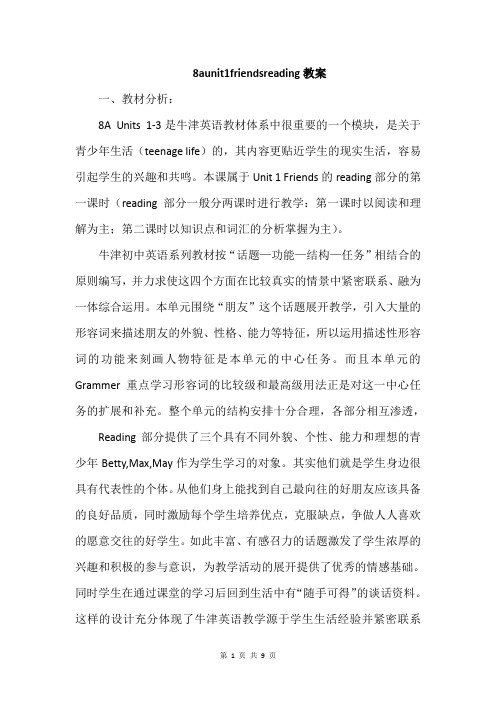
8aunit1friendsreading教案一、教材分析:8A Units 1-3是牛津英语教材体系中很重要的一个模块,是关于青少年生活(teenage life)的,其内容更贴近学生的现实生活,容易引起学生的兴趣和共鸣。
本课属于Unit 1 Friends的reading部分的第一课时(reading部分一般分两课时进行教学:第一课时以阅读和理解为主;第二课时以知识点和词汇的分析掌握为主)。
牛津初中英语系列教材按“话题—功能—结构—任务”相结合的原则编写,并力求使这四个方面在比较真实的情景中紧密联系、融为一体综合运用。
本单元围绕“朋友”这个话题展开教学,引入大量的形容词来描述朋友的外貌、性格、能力等特征,所以运用描述性形容词的功能来刻画人物特征是本单元的中心任务。
而且本单元的Grammer重点学习形容词的比较级和最高级用法正是对这一中心任务的扩展和补充。
整个单元的结构安排十分合理,各部分相互渗透,Reading部分提供了三个具有不同外貌、个性、能力和理想的青少年Betty,Max,May作为学生学习的对象。
其实他们就是学生身边很具有代表性的个体。
从他们身上能找到自己最向往的好朋友应该具备的良好品质,同时激励每个学生培养优点,克服缺点,争做人人喜欢的愿意交往的好学生。
如此丰富、有感召力的话题激发了学生浓厚的兴趣和积极的参与意识,为教学活动的展开提供了优秀的情感基础。
同时学生在通过课堂的学习后回到生活中有“随手可得”的谈话资料。
这样的设计充分体现了牛津英语教学源于学生生活经验并紧密联系学生生活实际的理念。
二、学情分析:1、年龄特点:八年级学生大部分是处于14、15岁左右的学生,处于生理、心理高速发育时期--青春期。
这时的学生渴望得到关心,希望得到别人的尊重和肯定;既渴望交朋友,又不会处理同学关系,因此表现得敏感多疑、固执、脆弱而且情绪易波动;青春期的孩子一方面认为自己长大了,想摆脱家人和老师的约束,另一方面又缺乏自控力、判断力,容易受外界的干扰;他们活泼好动,参与欲、表现欲非常强烈,但也有小部分学生性格孤僻、自卑内向、胆小;相当多学生较懒惰、贪玩,学习目的不太明确,对学习抱着单纯的求趣心理,追求知识要符合自己的兴趣,容易感情用事,对于自己感兴趣的东西就认真学,不感兴趣的就不学。
8A Unit1 Friends Reading(1)教学案
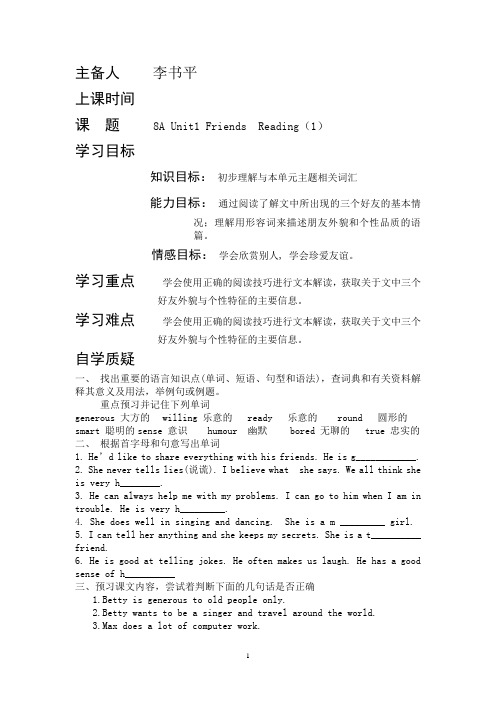
主备人李书平上课时间课题 8A Unit1 Friends Reading(1)学习目标知识目标:初步理解与本单元主题相关词汇能力目标:通过阅读了解文中所出现的三个好友的基本情况;理解用形容词来描述朋友外貌和个性品质的语篇。
情感目标:学会欣赏别人, 学会珍爱友谊。
学习重点学会使用正确的阅读技巧进行文本解读,获取关于文中三个好友外貌与个性特征的主要信息。
学习难点学会使用正确的阅读技巧进行文本解读,获取关于文中三个好友外貌与个性特征的主要信息。
自学质疑一、找出重要的语言知识点(单词、短语、句型和语法),查词典和有关资料解释其意义及用法,举例句或例题。
重点预习并记住下列单词generous 大方的willing 乐意的 ready 乐意的 round 圆形的smart 聪明的sense 意识 humour 幽默 bored 无聊的 true 忠实的二、根据首字母和句意写出单词1. He’d like to share everything with his friends. He is g____________.2. She never tells lies(说谎). I believe what she says. We all think she is very h________.3. He can always help me with my problems. I can go to him when I am in trouble. He is very h_________.4. She does well in singing and dancing. She is a m _________ girl.5. I can tell her anything and she keeps my secrets. She is a t__________ friend.6. He is good at telling jokes. He often makes us laugh. He has a good sense of h__________三、预习课文内容,尝试着判断下面的几句话是否正确1.Betty is generous to old people only.2.Betty wants to be a singer and travel around the world.3.Max does a lot of computer work.4.Max is very good at telling jokes.5.May is a true friend.6.May likes to tell others her friends’ secrets.课堂交流展示一、对课前自学中的重要的语言知识点(单词、短语、句型和语法)在组内和班内展示。
- 1、下载文档前请自行甄别文档内容的完整性,平台不提供额外的编辑、内容补充、找答案等附加服务。
- 2、"仅部分预览"的文档,不可在线预览部分如存在完整性等问题,可反馈申请退款(可完整预览的文档不适用该条件!)。
- 3、如文档侵犯您的权益,请联系客服反馈,我们会尽快为您处理(人工客服工作时间:9:00-18:30)。
8A Unit1 Friends教案Period 1 Comic Strip and Welcome to the unitTeaching Aims:Knowledge Aims:Teaching contents:Words: honest, joy, sad, believe, teenager, good-looking, musicalPhrases: have something to drink, make somebody happy/special, keep secrets,share one's joy, believe what somebody says, talk to somebody about anything,clean and tidySentences: Do you want some? Can I have something to drink?What about some milk? Can I have some more food too?There's nothing else in the fridge.Ability Aims:1. To learn about the new adjectives and expressions2. To describe the appearance and character of a friend with adjectives3 .To talk about the appearance and characterMoral Aims:Let the students talk about their friends happily.Focal point and difficulty:some more what about= how about nothing else make sb. + 形容词something to drink/eatnumbers + more elseTeaching steps:Step1 Warm-upT: Hello everyone, glad to see you again! Did you have a nice summer holiday? Are you happy to be back to school and see all your friends?Ss talk about their summer holidays.T: This summer holiday I went to Australia with some of your classmates and friends. We took a lot of photos. Would you like to have a look?Show the pictures and introduce some places of interest and animals in Australia.T: Look, we took a photo with this famous man--- Batman. He's a hero and people's good friend because he helps people in danger. Do you agree? What do you think of him?Ss talk about Batman with the adjectives describing appearance and personality, such as friendly, helpful, kind, polite, clever, brave, etc.Step 2 PresentationT: There are some more words to describe people. For example, we can say Batman is good-looking. But we never say he's beautiful! We don't use beautiful to describe a boy or a man. If someone likes music or is good at music, we say he or she is musical.Teach "good-looking"Step 3 Practice1. Play a guessing game. Ss describe their best friends in the class and guess who are talked about.2. T: Just now we heard some of the students talk about their best friends. Could you tell me which words are used most often?Ss: friendly, helpful, polite…T: So these are very important qualities of a best friend, do you think so? What other qualities are important to you?Ss complete the table in Part B, P7. Then work in pairs to exchange their ideas and have a debate.Sentences may be used:I think my good friend should be very … because…I agree. / I don't agree with you because …It's quite important for a friend to be …? Do you think so?I don't think my good friend must be very …3. T: Why do you think he/she is your best friend? What makes him/her so special to you? Can you talk to him/her about anything? Do you talk to him/her when you have problems? Do you believe what he/she says? When you are happy or sad, do you talk to him/her? Why?Teach "sad", "believe", "honest" and "joy".Ss complete Part A, P7 and report individually.4. T explains some language points.Step 4 Presentation1. T: How old is your best friend? What about you?Ss: 15/16 …T: So you are teenagers. We call children between 13 and 19 teenagers.Teach "teenager".T: We have a good friend, Eddie. Is he a teenager?Ss: No.2. T: Who's Eddie's good friend? Why?T plays the tape of the Comic strip and Ss try to find out the answer to the question.(Hobo is Eddie's good friend because they always share things with each other.)3. Ss read the Comic strip and answer the questions:(1) What does Eddie give Hobo?(2) What does Hobo want?(3) Do you think Eddie is a true friend? Why?4. Ss read the dialogue in pairs.5. T explains some language points.Step 5 Practice1. Ss act out the dialogue and they are encouraged to add in something they like.2. Discuss: Who do you like better as a friend, Eddie or Hobo? Why?3. Ss work in pairs to ask and answer about their good friends.A model dialogue:A: Who's your good friend?B: …A: What's he/she like?B: …A: What do you think of your friend?B: …A: What makes him/her so special to you?B: … Can you tell me something about your good friend?Step 6 SummarizeT: Today we have learned some important qualities about a good friend. It seems that we all think appearance is not so important, but a friend should be helpful and honest. And I hope everyone can be like that and you will have more friends.Step 7 Homework1. Describe a good friend of yours with the words and phrases learnt in this lesson.2. Finish the exercises.板书设计:Unit 1 Friends Welcome to the unit1 some more food 再一些食物2 what about= how about .....怎么样?3 nothing else 再没有东西4 make somebody happy 使某人开心5 share one's joy 分享某人的欢乐share sth. with sb.与某人分享某物6 make sb. + 形容词7 Can I have something to drink, please? 请问,我可以喝些东西吗?something to drink/eat 一些喝/吃的东西8There's nothing else in the fridge. 冰箱里面再没有东西了.这是一个there be 句型,不可用there have/has 来表示有else接在something 和nothing 的后面,表示“还,再”的意思。
